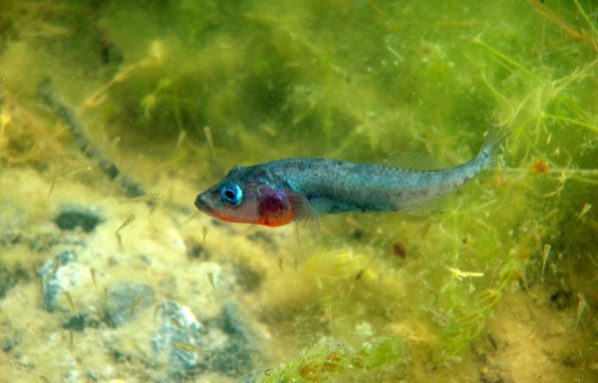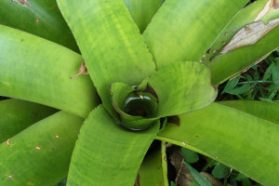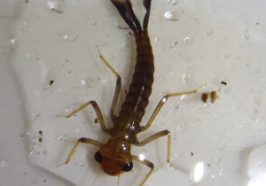Predators as climate helpers
In lakes and streams, fish and insects can help protect aquatic plants that gobble up greenhouse gas
By Janet Raloff

Too few bugs or fish could affect Earth’s climate in a big way, by contributing to the buildup of heat-trapping gases in the atmosphere, a new study finds. It’s a surprising example of what can happen when communities in nature become unbalanced.
Freshwater fish and insects normally feed on smaller aquatic animals. These include microscopic organisms called zooplankton. Those smaller guys in turn graze on algae and plants in the water. Those plants and algae don’t just sit at the bottom of the food chain. They also remove carbon dioxide from the water and release oxygen. It is a byproduct of photosynthesis. Algae alone produce about half the oxygen we breath.
Trisha Atwood of Canada’s University of British Columbia in Vancouver wondered what would happen to carbon dioxide levels in an aquatic environment if there were too few fish and insects at the top of this food chain. So she designed tests to find out.

In one experiment, Atwood diverted stream water into channels that she could control. For more than a year, she let the water in each channel naturally acquire living organisms. These included plankton — tiny animals, plants and algae that float. She also filled some large outdoor tanks with pond water and sediment, or debris that settles at the bottom of a liquid. Over many weeks, life naturally began to colonize these fake ponds too. Atwood’s team also went to Costa Rica to work with plants known as bromeliads. The center of each plant forms a tiny well, right where its leaves emerge from the stem. These wells collect maybe a tablespoon of water. The researchers let this water naturally accumulate living organisms too.
At the start of the experiment, the stream channels, ponds and bromeliad wells all contained a natural mix of photosynthesizing organisms and the zooplankton that eat them. The scientists then added a typical predator to half of each type of community, or ecosystem. For instance, half of the stream channels got a small fish called the three-spined stickleback. Half of the ponds got stonefly larvae. And half of the bromeliad wells got damselfly larvae. Once introduced, these predators began eating zooplankton.

Later, the scientists measured the carbon dioxide levels in each water body. They found a sharp difference between those ecosystems with top predators and those without. On average, there was 93 percent more carbon dioxide in the water without a stickleback, stonefly or damselfly. Atwood’s team reported its findings online Feb. 17 in Nature Geoscience.
Why more carbon dioxide? Without a predator to feed on them, the zooplankton simply multiplied out of control, explains coauthor John Richardson. He’s an ecologist at the University of British Columbia. And too many of those grazing animals, he says, left behind too few tiny plants and algae to suck up carbon dioxide from the water and store it in their tissues. So carbon dioxide levels in the water rose.
Climate scientists note that Earth will suffer excessive warming if levels of carbon dioxide and other greenhouse gases in the atmosphere get much higher. That’s why scientists have been looking for ways to encourage living organisms to act like a sponge, mopping up and storing much of that carbon dioxide. These carbon-storing species include trees, grasses and algae.
“Predators are disappearing from our ecosystems at alarming rates because of hunting and fishing pressure and because of human induced changes to their habitats,” says Atwood.
This new study suggests that carbon-storing plants and related species may have trouble mopping up the carbon dioxide if our activities continue to kill off top predators, she says.
The new findings make sense, says James Estes. An ecologist at the University of California, Santa Cruz, he did not participate in the research. Anything that promotes carbon uptake by plants will keep carbon dioxide from moving into the surrounding environment, Estes says. That is just what the predators did in the new study, by reducing zooplankton populations. Several other research teams (including his) have investigated this idea. But they didn’t look at as broad of a range of ecosystems as Atwood’s team did. Estes concludes that the new findings suggest this predator effect “may be fairly general.” That means it might not just at work in freshwater ecosystems.
Power Words
algae A large group of organisms ranging from meters-long seaweeds to single-celled microorganisms. Most algae are photosynthetic, meaning that they use light and carbon dioxide to make sugar and oxygen.
carbon dioxide A colorless, odorless gas. Burning fossil fuels such as coal, oil or natural gas produces large amounts of carbon dioxide, which traps heat in Earth’s atmosphere. Plants, as well as plantlike phytoplankton (including algae), absorb carbon dioxide during photosynthesis.
ecologist A scientist who studies the branch of biology that examines how organisms interact with each other and their environment.
ecosystem The natural community of plants, animals and microorganisms that evolved to live together in a particular place with a particular climate. Examples include tropical reefs, rainforests, alpine meadows and polar tundra.
greenhouse gases Any of various gases that trap heat in the atmosphere. Carbon dioxide is the leading greenhouse gas in Earth’s atmosphere.
plankton Tiny floating animals (known as zooplankton) in the water that feed on single-celled plants and plantlike organisms (called phytoplankton) that also float in the water.







